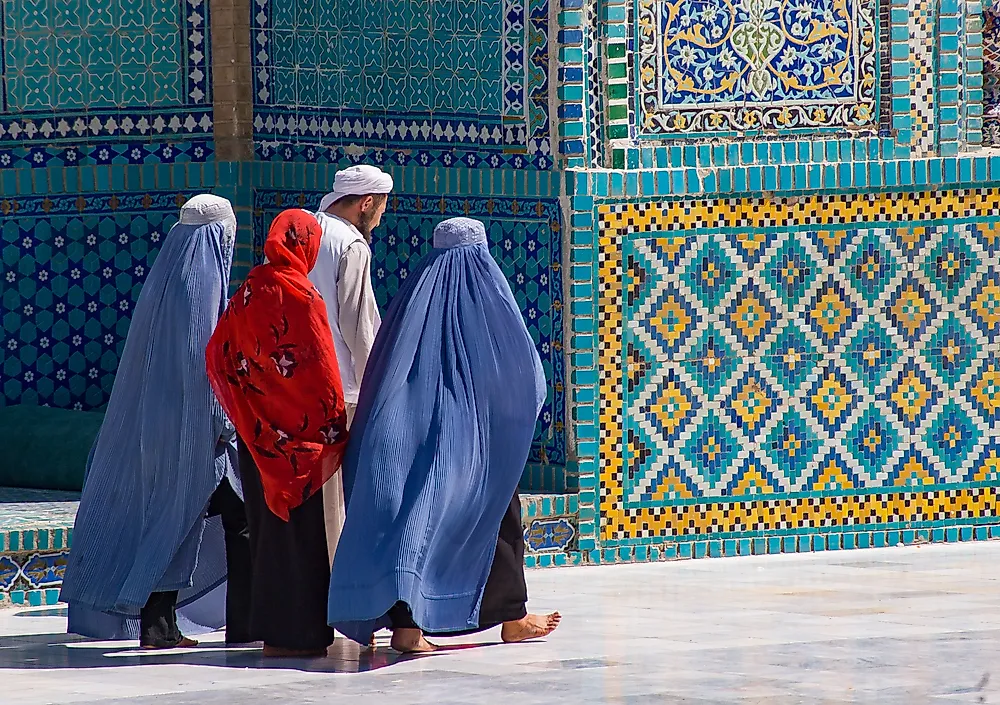The Ethnic Groups Of Afghanistan

Afghanistan is a country in Central Asia. The country is located along historic trade routes, and those used by militaries during invasions, between Eastern Asia and Western Asia. It therefore enjoys a mixture of cultures borrowed from Europe, Eastern and Western Asia. The official languages in Afghanistan are Pashto and Dari. Many Afghans are bilingual. They use proverbs and common sayings in their daily conversation. Spiced rice dishes are a staple in Afghanistan. Tea is an integral beverage in their homes. Afghanistan’s beautiful architecture is seen in their mosques and homes. They practice subsistence farming and also keep livestock. Pashtun make up the largest ethnic group in Afghanistan, followed by Tajiks, Hazara, Uzbek, Aimaks, Baloch, and others.
Pashtuns
Pashtuns make up an estimated 42% of the population of contemporary Afghanistan. They are also known as Afghans and the name ‘Afghanistan’ translates to ‘land of the Afghans’, equally meaning ‘land of the Pashtuns’. Pashtuns can further be divided into major sub-tribes, such as the Ghilzali and Durrani, and several smaller ones, including the Jaji, Safi, Wardak, Shinwari, Tani, Mohmand, Jardan, Khungiani, and Mangal. They are easily recognized form other Afghans by their Pashto language and their unique way of living called Pashtinwali.
Pashtuns are predominantly Muslim. Islam has a significant influence on the Pashtun culture such as their clothing. The women wear long dresses and cover their heads. Men wear loose-fitting shirts that are of knee length and trousers tied to the waist with string. Pashtun cuisine is popular for its use of dried fruits. A famous dish in Pashtun homes is Pulao which is a spiced rice meal. They are forbidden from eating pork or indulging in alcoholic drinks. Pashtuns are traditionally nomadic pastoralists who move from place to place in search of grazing land.
Tajik
Tajiks are believed to have Iranian origins, and are also referred to as Farsi. They are the second largest ethnic group in Afghanistan, making up an estimated 27% of the nation’s population. They speak a Persian dialect known as Dari. According to a US State Department report released in 2009, Tajiks are 98% Sunni Muslims. Tajiks' meals range from sweet dishes such as Halwa to savory ones such as Pulao (spiced rice). Tajiks are famous for their elaborate embroideries on fabric. These beautiful patterns are also found on their carpets, wall hangings and head pieces. Decorative carvings on stone can be seen in Tajik homes.
Hazara
Hazaras occupy the rugged central highlands regions in Afghanistan. They make up close to 10% percent of the Afghanistan population. Hazaras are said to be descendants of Genghis Khan, the founder of the Mongol Empire. Hazaras belong to the Shia sect of Islam in a country that is mostly Sunni Muslim. As a result, they are often viewed as outsiders.
Uzbek
Uzbeks form the largest Turkic group in Afghanistan, and they constitute 9% of the total population in the country. They are Sunni Muslims and occupy the Northern region of Afghanistan. They speak Uzbek, a Turkic language.
Aimaq
The Aimaq are a group of Persian-speaking nomadic tribes, and they constitute 4% of the total population in the country. Aimaqs live in Western Afghanistan. Women adorn themselves in brightly colored clothes while men wear cloaks and round caps. Interestingly, Aimaq women are not as restricted as other women in rural Afghanistan. They take part in group discussions with men and have a say in the choice of a groom for them.
Other major ethnic groups in Afghanistan include Turkmen (3%) and Balochi (Baluch) (2%). There are others which do not belong to any of these aforementioned ethic groups, and collectively they make up 5% of the total population in the country.
Ethnic Groups Of Afghanistan
| Rank | Ethnic Group | Share of Population of Afghanistan |
|---|---|---|
| 1 | Pashtun (Pashto) | 42% |
| 2 | Tajik | 27% |
| 3 | Uzbek | 9% |
| 4 | Hazara | 8% |
| 5 | Aimaq | 4% |
| 6 | Turkmen | 3% |
| 7 | Balochi (Baluch) | 2% |
| Other Groups | 5% |











